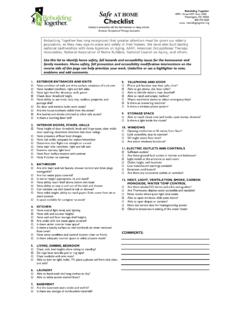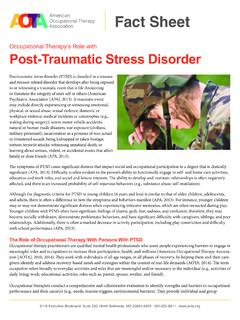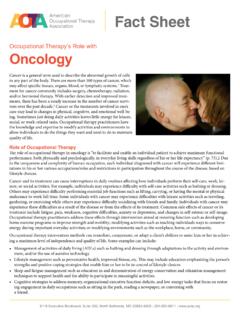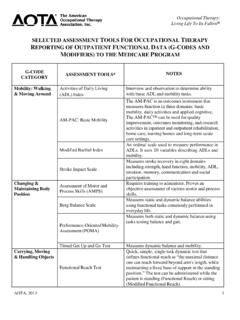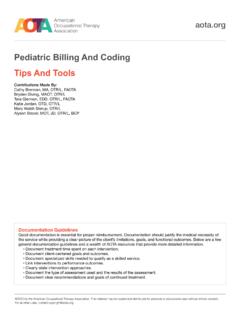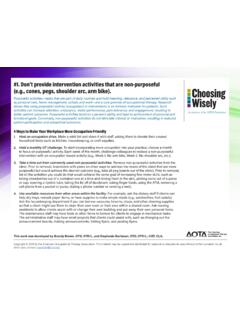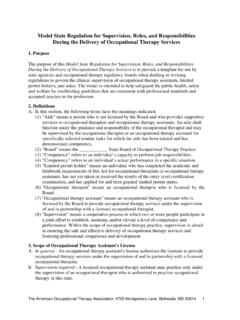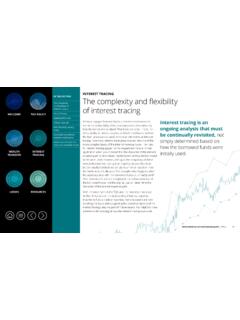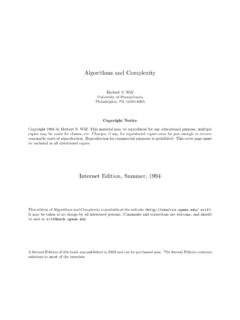Transcription of New Occupational Therapy Evaluation Coding Overview
1 Montgomery Lane, Bethesda, MD 20814-3425 Phone: 301-652-2682 TDD: 800-377-8555 Fax: 301-652-7711 CELEBRATING1917 20171 CPT copyright 2016 American Medical Association. All rights reserved. CPT is a registered trademark of the American Medical Occupational Therapy Evaluation Coding Overview On January 1, 2017, new codes will go into effect for Occupational Therapy evaluations. The American Medical Association (AMA) Common Procedural Terminology (CPT ) 2017 manual will list three levels of Occupational thera-py Evaluation and one level of re- Evaluation under the Physical Medicine and Rehabilitation (PM&R) section of the manual (or codebook). The previous codes have been redefined and assigned new numbers with new requirements.
2 To use the correct code in the new system, Occupational therapists will have to attend to new criteria that distinguish differing levels of Evaluation . This document is intended to provide an Overview of the codes to assist occupation-al therapists with making correct Coding choices that reflect modern Occupational Therapy practice. The new CPT codes describe differences in complexity of evaluations, ranging from low ( , straightforward), to moderate ( , in-volved), to high ( , very complex). Previously, when an Occupational therapist performed an Evaluation of a client, only one code (97003) was available to reflect the clinical work accomplished during that Evaluation new Evaluation codes (97165, 97166, and 97167) will replace CPT code 97003 and offer three levels of an Occupational Therapy Evaluation : low, moderate, and high.
3 There is one re- Evaluation code (97168).The code descriptors as published in the CPT manual are available on AOTA s website at New man-uals are available in print and online from the new codes were developed through a process involving the AMA (which develops, publishes, and owns the CPT system), the American Occupational Therapy Association (AOTA), and other professional societies. Payers, including Medicare, Medicaid, and insurance providers, use these codes to identify services for payment. Medicare will begin using these codes on January 1, 2017, and most other third-party payers ( , Medicaid, insur-ers) will follow this procedure by developing individual payer policies on use of and payment for codes.
4 HOW CPT DESCRIBES THE Occupational Therapy Evaluation AND REEVALUTION CODESF irst, it is important to review and understand the precise language in the 2017 AMA CPT manual. It provides the following introduction to the codes for Occupational Therapy Evaluation : Occupational Therapy evaluations include an Occupational profile, medical and Therapy history, relevant assessments, and develop-ment of a plan of care, which reflects the therapist s clinical reasoning and interpretation of the data. Coordination, consideration, and collaboration of care with physicians, other qualified health care professionals, or agencies is provided consistent with the nature of the problem(s) and the needs of the patient, family, and/or other caregivers.
5 (p. 664)The definition follows the approach to Evaluation in the Occupational Therapy Practice Framework: Domain and Process (3rd ed.; AOTA, 2014). The Framework will be referenced throughout this document, as it provides import-ant direction for conducting appropriate, best-practice evaluations. The new descriptions in CPT set the stage for promoting optimal Occupational Therapy practice. By conducting a profile, doing standardized and other tests and measures, and showing the breadth of concerns Occupational Therapy considers, we promote distinct value. The Evaluation process can communicate to others the full scope of Occupational Therapy practice. The codes can be a tool to promote distinct value.
6 New Occupational Therapy Evaluation Coding Overview Montgomery Lane, Bethesda, MD 20814-3425 Phone: 301-652-2682 TDD: 800-377-8555 Fax: 301-652-7711 CELEBRATING1917 20172 DETERMINING THE CORRECT LEVEL OF EVALUATIONThe Code Language on Levels In these new codes, the CPT describes exactly what should be done in an Evaluation :n Occupational profile and client history (medical and Therapy ) n Assessments of Occupational performancen Clinical decision makingn Development of plan of careIdentifying and Reporting the complexity level of an Evaluation focuses on the first three of these factor profile and history, assessment and determination of deficits, and clinical decision making.
7 These three factors must be scored and de-fensible documentation written to support the choice of a level. The development of the Plan of Care (POC) is part of the overall Evaluation process and must reflect how and why you scored the Evaluation as high, moderate or low. The three components are the factors that payers and others will review to assure the therapist has chosen the right code level. But in a best practice Occupational Therapy Evaluation , all the factors are integrated. In best practice, for instance, clinical decision making transcends all parts of the Evaluation . How assessments are conducted is related to the determination of performance limitations and deficits.
8 Best Occupational Therapy practice recognizes that all three CPT factors that determine a level are integrated into a holistic Evaluation , and that other factors, such as age or environment, are also considered. The plan of care reflects the process and outcomes of the therapist s atten-tion to each of the CPT factors in the context of the whole Evaluation to meet the patient s or client s needs. The CPT requirements do not mean that a therapist provides an Evaluation using only these three components. The three components are what must be validated in choosing a level but a sufficient Evaluation must be provid-ed as appropriate to Occupational Therapy practice. Why a particular level was chosen should be supported in the documentation of the codes direct that each component must be given a level.
9 The level is most likely determined after completion of the Evaluation , but therapists should be familiar with the criteria at the start so they can be considering the level as they proceed through the Evaluation . Choose a Level That is AppropriateLevels must be determined specifically for each of the three components in order to choose the correct code. In order to move to a higher level of Evaluation all three components must be of the higher level. For example, if the profile and history are moderate and the assessment of Occupational performance and iden-tification of deficits is moderate, but the clinical decision making com-ponent is high, the Evaluation must still be coded moderate.
10 Therapists complexity Level ExampleProfile and HistoryAssessment of Occupa-tional Performance and Identification of DeficitsClinical Decision MakingLowModerateHighn complexity LevelNew Occupational Therapy Evaluation Coding Overview Montgomery Lane, Bethesda, MD 20814-3425 Phone: 301-652-2682 TDD: 800-377-8555 Fax: 301-652-7711 CELEBRATING1917 20173must remember that they are ethically, and in some cases legally, required to choose and report the correct code. The code design considers the presenting patient condition, the analytical work of the therapist, and assessment and identification of the scope and nature of the client s/patient s performance concerns and goals. A proper evalu-ation involves a broader view and other components.

